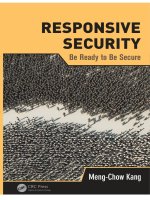Hacking ebook informationsecurityfundamentals
Bạn đang xem bản rút gọn của tài liệu. Xem và tải ngay bản đầy đủ của tài liệu tại đây (25.78 MB, 424 trang )
Information Security
FUNDAMENTALS
Second Edition
Thomas R. Peltier
Information Security
FUNDAMENTALS
Second Edition
Information Security
FUNDAMENTALS
Second Edition
Thomas R. Peltier
CRC Press
Taylor & Francis Group
6000 Broken Sound Parkway NW, Suite 300
Boca Raton, FL 33487-2742
© 2014 by Taylor & Francis Group, LLC
CRC Press is an imprint of Taylor & Francis Group, an Informa business
No claim to original U.S. Government works
Version Date: 20130626
International Standard Book Number-13: 978-1-4398-1063-7 (eBook - PDF)
This book contains information obtained from authentic and highly regarded sources. Reasonable efforts
have been made to publish reliable data and information, but the author and publisher cannot assume
responsibility for the validity of all materials or the consequences of their use. The authors and publishers
have attempted to trace the copyright holders of all material reproduced in this publication and apologize to
copyright holders if permission to publish in this form has not been obtained. If any copyright material has
not been acknowledged please write and let us know so we may rectify in any future reprint.
Except as permitted under U.S. Copyright Law, no part of this book may be reprinted, reproduced, transmitted, or utilized in any form by any electronic, mechanical, or other means, now known or hereafter invented,
including photocopying, microfilming, and recording, or in any information storage or retrieval system,
without written permission from the publishers.
For permission to photocopy or use material electronically from this work, please access www.copyright.
com ( or contact the Copyright Clearance Center, Inc. (CCC), 222 Rosewood
Drive, Danvers, MA 01923, 978-750-8400. CCC is a not-for-profit organization that provides licenses and
registration for a variety of users. For organizations that have been granted a photocopy license by the CCC,
a separate system of payment has been arranged.
Trademark Notice: Product or corporate names may be trademarks or registered trademarks, and are used
only for identification and explanation without intent to infringe.
Visit the Taylor & Francis Web site at
and the CRC Press Web site at
To the souls that left us too early: Justin Peltier, Gene Schultz,
and Brad Smith. They were always eager to try new things first—
I know they will make our next meeting a joyous occasion.
Contents
Acknowledgments...........................................................................................ix
Introduction....................................................................................................xi
Information Security Fundamentals............................................................ xiii
Editor........................................................................................................... xxv
Contributors...............................................................................................xxvii
1 Developing Policies.................................................................................1
THOMAS R. PELTIER
2 Organization of Information Security..................................................17
PATRICK D. HOWARD
3 Cryptology............................................................................................37
MARIA DAILEY
4 Risk Management: The Facilitated Risk Analysis and Assessment
Process...................................................................................................59
THOMAS R. PELTIER
5 Building and Maintaining an Effective Security Awareness
Program...............................................................................................109
JOHN G. O’LEARY
6 Physical Security.................................................................................147
JOHN A. BLACKLEY
7 Disaster Recovery and Business Continuity Planning........................ 161
KEVIN McLAUGHLIN
8 Continuity of Operations Planning....................................................169
JEFFERY SAUNTRY
vii
viii ◾ Contents
9 Access Controls...................................................................................219
KIMBERLY LOGAN
10 Information System Development, Acquisition, and Maintenance.....239
QUINN R. SHAMBLIN
11 Information Security Incident Management.......................................273
BRAD SMITH
12 Asset Classification..............................................................................297
THOMAS R. PELTIER AND WILLIAM TOMPKINS
13 Threats to Information Security..........................................................327
JUSTIN PELTIER
14 Information Security Policies: A Practitioner’s View..........................349
CHARLES JOHNSON
Glossary.......................................................................................................357
Appendix A: Facilitated Risk Analysis and Assessment Process (FRAAP).....369
Appendix B: Business Impact Analysis........................................................383
KEVIN McLAUGHLIN
Acknowledgments
This book is the combined effort of many industry professionals. This group
includes John Blackley, Maria Dailey, Pat Howard, Charles Johnson, Kimberly
Logan, Kevin McLaughlin, John O’Leary, Justin Peltier, Tom Peltier, Jeff Sauntry,
Quinn Shamblin, Brad Smith, and William Tompkins.
For more than a decade, SecureWorld has expanded and improved the concept
of affordable regional security conferences. By ensuring knowledgeable speakers and
quality educational and training programs, the security professional is able to stay
current and cultivate contacts to help provide a means to get questions answered
and problems solved. Mike O’Gara, Kerry Nelson, and the entire SecureWorld
team are serving the industry well.
No one has all the answers to any question, so the really “smart” person cultivates good friends. Being in the information security business for nearly 40 years,
I have had the great good fortune of having a number of such friends and fellow
professionals. This group of longtime sources of great information includes John
and Jane O’Leary, Lisa Bryson, Mike Corby, Terri Curran, Peter Stephenson,
Merrill Lynch, Bob Cartwright, Pat Howard, Cheryl Jackson, Becky Herold,
Ray Kaplan, Anne Terwilliger, David Lynas, John Sherwood, Herve Schmidt,
Antonio and Pietro Ruvolo, Wayne Sumida, Dean Feldpausch, and William H.
Murray.
My working buddies also need to be acknowledged. My son Justin was the
greatest asset any father and information security team could ever hope for. Over
the years, we logged thousands of air miles together and touched five continents.
Every day I learned something new from him. I miss him greatly each and every
day.
The other working buddy is John Blackley, a strange Scotsman who makes my
life more fun and interesting. I’ve worked with John since 1985 and have marveled
at how well he takes obtuse concepts and condenses them so that even management
types can understand.
ix
x ◾ Acknowledgments
Who can leave out their publisher? Certainly not me. Rich O’Hanley has taken
the time to discuss security issues with numerous organizations to understand what
their needs are and then presented these findings to us. A great deal of our work
here is a direct result of what Rich discovered that the industry wanted. Rich is not
only the world’s best editor and taskmaster but also a good friend and source of
knowledge. Thanks, Rich!
Introduction
The purpose of information security is to protect an organization’s valuable
resources, such as information, computer hardware, and software. Through the
selection and application of appropriate safeguards, security helps an organization’s
mission by protecting its physical and financial resources, reputation, legal position,
employees, and other tangible and intangible assets. To many, security is sometimes
viewed as thwarting the business objectives of an organization by imposing poorly
selected, bothersome rules and procedures on users, managers, and systems. Wellchosen security rules and procedures do not exist for their own sake—they are
put in place to protect important assets and thereby support the overall business
objectives.
Developing an information security program that adheres to the principle of
security as a business enabler is the first step in an enterprise’s effort to build an
effective security program. Organizations must continually (1) explore and assess
information security risks to business operations; (2) determine what policies,
standards, and controls are worth implementing to reduce these risks; (3) promote
awareness and understanding among the staff; and (4) assess compliance and control effectiveness. As with other types of internal controls, this is a cycle of activity,
not an exercise with a defined beginning and end.
This book has been designed to give the information security professional a
solid understanding of the fundamentals of security and the entire range of issues
the practitioner must address. We hope that you will be able to take the key elements that comprise a successful information security program and implement the
concepts into your own successful program. Each chapter has been written by a
different author and will ensure that the reader gets the benefit of different ideas
and approaches.
xi
Information Security
Fundamentals
Overview
The purpose of information security is to protect an organization’s valuable
resources, such as information, hardware, and software. Through the selection and
application of appropriate safeguards, security helps an organization to meet its
business objectives or mission by protecting its physical and financial resources,
reputation, legal position, employees, and other tangible and intangible assets. We
will examine the elements of computer security, employee’s roles and responsibilities, and common threats. We will also examine the need for management controls,
policies and procedures, and risk management. Finally, we will include current
examples of procedures, policies, and examples that can be used to help implement
the security program at your organization.
Elements of Information Security
Information security should be based on eight major elements:
1.Information security should support the business objectives or mission of the
enterprise. This idea cannot be stressed enough. All too often, information
security personnel lose track of their goals and responsibilities. The position
of information security professional has been created to support the enterprise, not the other way around.
2.Information security is an integral element of fiduciary duty. Senior management is charged with two basic responsibilities: a duty of loyalty—this means
that whatever decisions they make must be made in the best interest of the
enterprise. They are also charged with a duty of care—this means that senior
management is required to implement reasonable and prudent controls to
protect the assets of the enterprise and make informed business decisions.
xiii
xiv ◾ Information Security Fundamentals
An effective information security program will assist senior management in
meeting these duties.
3.Information security must be cost-effective. Implementing controls based on
edicts is counter to the business climate. Before any control can be proposed,
it will be necessary to confirm that a significant risk exists. Implementing a
timely risk management process can complete this task. By identifying risks
and then proposing appropriate controls, the mission and business objectives
of the enterprise will be better met.
4.Information security responsibilities and accountabilities should be made
explicit. For any program to be effective, it will be necessary to publish an
information security policy statement and a group mission statement. The
policy should identify the roles and responsibilities of all employees. To
ensure third parties comply with our policies and procedures, the contract
language indicating these requirements must be incorporated into the purchase agreements for all contract personnel and consultants.
5.System owners have information security responsibilities outside their own
organization. Access to information will often extend beyond the business unit or even the enterprise. It is the responsibility of the information
owner (normally the senior level manager in the business that created the
information or is the primary user of the information). One of the main
responsibilities is to monitor usage to ensure that it complies with the level of
authorization granted to the user.
6.Information security requires a comprehensive and integrated approach. To
be as effective as possible, it will be necessary for information security issues
to be part of the system development life cycle. During the initial or analysis
phase, information security should receive as its deliverables a risk assessment,
a business impact analysis, and an information classification document.
Additionally, because information is resident in all departments throughout
the enterprise, each business unit should establish an individual responsible
for implementing an information security program to meet the specific business needs of the department.
7.Information security should be periodically reassessed. As with anything,
time changes the needs and objectives. A good information security program
will examine itself on a regular basis and make changes wherever and whenever necessary. This is a dynamic and changing process and therefore must be
reassessed at least every 18 months.
8.Information security is constrained by the culture of the organization. The
information security professional must understand that the basic information
security program will be implemented throughout the enterprise. However,
each business unit must be given the latitude to make modifications to meet
their specific needs. If your organization is multinational, it will be necessary
to make adjustments for each of the various countries. These adjustments will
Information Security Fundamentals ◾ xv
have to be examined throughout the United States too. What might work in
Des Moines, Iowa, may not fly in Berkley, California. Provide for the ability
to find and implement alternatives.
Information security is a means to an end and not the end in itself. In business, having an effective information security program is usually secondary to the
need to make a profit. In the public sector, information security is secondary to the
agency’s services provided to its constancy. We, as security professionals, must not
lose sight of these goals and objectives.
Information systems and the information processed on them are often considered to be critical assets that support the mission of an organization. Protecting
them can be as important as protecting other organizational resources such as
financial resources, physical assets, and employees. The cost and benefits of information security should be carefully examined in both monetary and nonmonetary
terms to ensure that the cost of controls does not exceed the expected benefits.
Information security controls should be appropriate and proportionate.
The responsibilities and accountabilities of the information owners, providers,
and users of computer services and other parties concerned with the protection of
information and computer assets should be explicit. If a system has external users,
its owners have a responsibility to share appropriate knowledge about the existence
and general extent of control measures so that other users can be confident that the
system is adequately secure. As we expand the user base to include suppliers, vendors, clients, customers, shareholders, and the like, it is incumbent upon the enterprise to have clear and identifiable controls. For many organizations, the initial
sign-on screen is the first indication that there are controls in place. The message
screen should include three basic elements:
1.The system is for authorized users only
2.Activities are monitored
3.By completing the sign-on process, the user agrees to the monitoring
More than Just Computer Security
Providing effective information security requires a comprehensive approach that
considers a variety of areas both within and outside of the information technology
area. An information security program is more than establishing controls for the
computer-held data. In 1965, the idea of the “paperless office” was first introduced.
The advent of third-generation computers brought about this concept. However,
today, a vast quantity of all the information available to employees and others is
still found in nonelectronic form. To be an effective program, information security
must move beyond the narrow scope of IT and address the issues of enterprise-wide
xvi ◾ Information Security Fundamentals
information security. A comprehensive program must touch every stage of the
information asset life cycle from creation to eventual destruction.
Employee Mindset Toward Controls
Access to information and the environments that process them are dynamic.
Technology and users, data and information in the systems, and the risks associated with the system and security requirements are ever changing. The ability of
information security to support business objectives or the mission of the enterprise
may be limited by various factors, such as the current mindset toward controls.
A highly effective method of measuring the current attitude toward information security is to conduct a “walkabout.” After hours or on a weekend, conduct
a review of the workstations throughout a specific area (usually a department or a
floor) and look for just five basic control activities:
1.Offices secured
2.Desks and cabinets secured
3.Workstations secured
4.Information secured
5.Electronic media secured
When conducting an initial walkabout, the typical office environment will
have a 90% to 95% noncompliance rate with at least one of these basic control
mechanisms. The result of this review should be used to form the basis for an initial
risk assessment to determine the security requirements for the workstation area.
When conducting such a review, employee privacy issues must be remembered.
Roles and Responsibilities
As discussed previously, senior management has the ultimate responsibility for
the protection of the organization’s information assets. One of the responsibilities is the establishment of the function of Corporate Information Security Officer
(CISO). The CISO directs the organization’s day-to-day management of information assets. The Security Administrator should report directly to the CIO and is
responsible for the day-to-day administration of the information security program.
Supporting roles are performed by the service providers and include Systems
Operations, whose personnel design and operate the computer systems. They are
responsible for implementing technical security on the systems. Telecommunications
is responsible for providing communication services, including voice, data, video,
and wireless.
Information Security Fundamentals ◾ xvii
The information security professional must also establish strong working relationships with the Audit staff. If the only time you see the audit staff is when they
are in for a formal audit, then you probably don’t have a good working relationship.
It is vitally important that this liaison is established and that you meet to discuss
common problems at least each quarter.
Other support groups include the Physical Security staff and the Contingency
Planning group. These groups are responsible for establishing and implementing
controls and can form a peer group to review and discuss controls. The group responsible for application development methodology will assist in the implementation of
information security requirements in the application system development life cycle.
Quality assurance can assist in ensuring that information security requirements are
included in all development projects before moving on to production.
The Procurement Group can work to get the language of the information security policies included in the purchase agreements for contract personnel. Education
and Training can assist in the development and conducting of information security
awareness programs and for training supervisors in the responsibility to monitor
employee activities. Human Resources will be the organization responsible for taking appropriate action for any violations of the organization’s information security
policy.
An example of a typical job description for an information security professional
is shown in Figure I.1.
Common Threats
Information processing systems are vulnerable to many threats that can inflict various types of damage, resulting in significant losses. This damage can range from
errors harming database integrity to fires destroying entire complexes. Losses can
stem from the actions of supposedly trusted employees defrauding a system, from
outside hackers, or from careless data entry. Precision in estimating information
security–related losses is not possible because many losses are never discovered,
whereas others are hidden to avoid unfavorable publicity.
The typical computer criminal is an authorized, nontechnical user of the system
who has been around long enough to determine what actions would cause a “red
flag” or an audit. The typical computer criminal is an employee. According to a
recent survey in Current and Future Danger: A CSI Primer on Computer Crime &
Information Warfare by Richard Power, more than 80% of the respondents identified employees as a threat or potential threat to information security. Also included
in this survey were the competition, contract personnel, public interest groups,
suppliers, and foreign governments.
The chief threat to information security is still errors and omissions. This concern continues to make up 65% of all information loss problems. Users, data entry
xviii ◾ Information Security Fundamentals
Director, Design and Strategy
Location:
Anywhere, World
Practice Area:
Corporate Global Security Practice
Grade:
Purpose:
To create an information security design and strategy practice that defines the technology structure needed to address the security needs of its clients. The information security design and
strategy will complement security and network services developed by the other Global Practice
areas. The design and strategy practice will support the clients’ information technology and
architecture and integrate with each enterprise’s business architecture. This security framework
will provide for the secure operation of computing platforms, operating systems, and networks,
both voice and data, to ensure the integrity of the clients’ information assets. To work on corporate initiatives to develop and implement the highest quality security services and ensure that
industry best practices are followed in their implementation.
Working Relationships
This position reports in the Global Security Practice to the Vice President, Global Security. Internal
contacts are primarily Executive Management, Practice Directors, Regional Management as well
as mentoring and collaborating with consultants. This position will directly manage two professional positions: Manager, Service Provider Security Integration and Service Provider Security
Specialist. Frequent external contacts include building relationships with clients, professional
information security organizations, other information security consultants, vendors of hardware, software, and security services, and various regulatory and legal authorities.
Principal Duties and Responsibilities
The responsibilities of the Director, Design and Strategy include, but are not limited to, the
following:
• Develop global information security services that will provide the security functionality
required to protect clients’ information assets against unauthorized disclosure, modification, and destruction. Particular focus areas include:
• Wireless security
• Virtual private networks
• Data privacy
• Virus prevention
• Secure application architecture
• Service provider security solutions
• Develop information security strategy services that can adapt to clients’ diverse and
changing technological needs
• Work with network and security practice leaders and consultants to create sample architectures that communicate the security requirements that will meet the needs of all client
network implementations
• Work with practice teams to aid them from the conception phase to the deployment of the
project solution. This includes quality assurance review to ensure that the details of the
project are correctly implemented according to the service delivery methodology
• Work with the clients to collect their business requirements for electronic commerce,
while educating them on the threats, vulnerabilities, and available risk mitigation
strategies
Figure I.1 Sample information security job description.
Information Security Fundamentals ◾ xix
• Determine where and how cryptography should be used to provide public key infrastructure and secure messaging services for clients
• Participate in security industry standards bodies to ensure strategic information security
needs will be addressed
• Conduct security focus groups with the clients to cultivate an effective exchange of business plans, product development, and marketing direction to aid in creating new and
innovative service offerings to meet client needs
• Continually evaluate vendors’ product strategies and future product statements and
advise, which will be most appropriate to pursue for alliances, especially in the areas of:
• Remote access
• Data privacy
• Virus prevention
• Secure application architecture
• Service provider security solutions
• Provide direction and oversight of hardware-based and software-based cryptography
ser v ice development efforts
Accountability
Maintain the quality and integrity of the services offered by the Global Security Practice. Review
and report impartially on the potential viability and profitability of new security services. Assess
the operational efficiency, compliance to industry standards, and effectiveness of the client network designs and strategies that are implemented through the company’s professional service
offerings. Exercise professional judgment in making recommendations that may affect business
operations.
Knowledge and Skills
• 40% Managerial/practice management
• Ability to supervise a multidisciplinary team and a small staff; must handle multiple tasks
simultaneously; ability to team with other Practice Directors and Managers to develop
strategic service offerings
• Willingness to manage or to personally execute necessary tasks, as resources are required
• Excellent oral, written, and presentation skills
• 10% Technical
• In-depth technical knowledge of information processing platforms, operating systems,
and networks in a global distributed environment
• Ability to identify and apply security techniques to develop services to reduce clients’ risk
in such an environment
• Technical experience in industrial security, information systems architecture, design, and
development, physical and data security, telecommunication networks, auditing techniques, and risk management principles
• Excellent visionary skills that focus on scalability, cost-effectiveness, and ease of implementation
• 25% Business
• Knowledge of business information flow in a multinational, multiplatform networked
environment
• Solid understanding of corporate dynamics and general business processes; understanding of multiple industries
• Good planning and goal-setting skills
• 25% Interpersonal
• Must possess strong consulting and communication skills
• Ability to work with all levels of management to resolve issues
• Must understand and differentiate between tactical and strategic concepts
• Must be able to weigh business needs with security requirements
• Must be self-motivated
Figure I.1 (Continued) Sample information security job description.
xx ◾ Information Security Fundamentals
Attributes
Must be mature, self-confident, and performance-oriented. Will clearly demonstrate an ability
to lead technological decisions. Will establish credibility with personal dedication, attention to
detail, and a hands-on approach. Will have a sense of urgency in establishing security designs
and strategies to address new technologies to be deployed addressing clients’ business needs.
Will also be capable of developing strong relationships with all levels of management. Other
important characteristics will be the ability to function independently, holding to the highest
levels of personal and professional integrity. Will be an excellent communicator and team player.
Specific requirements include:
• Bachelor’s degree (Master’s degree desirable)
• Advanced degree preferred
• Fifteen or more years of information technology consulting or managerial experience,
eight of those years spent in information security positions
• CISM or CISSP certification preferred (other appropriate industry or technology certifications desirable)
Potential Career Path Opportunities
Opportunities for progression to a VP position within the company
Figure I.1 (Continued) Sample information security job description.
personnel, system operators, programmers, and the like frequently make errors that
contribute directly or indirectly to this problem.
Dishonest employees make up another 13% of information security problems.
Fraud and theft can be committed by insiders and outsiders, but it is more likely
to be done by employees. In a related area, disgruntled employees make up another
10% of the problem. Employees are most familiar with the organization’s information assets and processing systems, including knowing what actions might cause
the most damage, mischief, or sabotage.
Common examples of information security–related employee sabotage include
destroying hardware or facilities, planting malicious code (viruses, worms, Trojan
horses, etc.) to destroy data or programs, entering data incorrectly, deleting data,
altering data, and holding data “hostage.”
The loss of the physical facility or the supporting infrastructure (power failures,
telecommunications disruptions, water outage and leaks, sewer problems, lack of
transportation, fire, flood, civil unrest, strikes, etc.) could lead to serious problems
and make up 8% of all information security–related problems.
The final area is malicious hackers or crackers. These terms refer to those who break
into computers without authorization or exceed the level of authorization granted to
them. Although these problems get the largest amount of press coverage and movies,
they only account for 5% to 8% of the total picture. They are real, however, and they
can cause a great deal of damage. But when attempting to allocate limited information security resources, it may be better to concentrate efforts in other areas. To be
certain, conduct a risk assessment to identify what your exposure might be.
Information Security Fundamentals ◾ xxi
Policies and Procedures
An information security policy is the documentation of enterprise-wide decisions
on handling and protecting information. In making these decisions, managers face
hard choices involving resource allocation, competing objectives, and organization
strategy related to protecting both technical and information resources as well as
guiding employee behavior.
When creating an information security policy, it is best to understand that
information is an asset of the enterprise and is the property of the organization. As
such, information reaches beyond the boundaries of IT and is present in all areas
of the enterprise. To be effective, an information security policy must be part of the
organization’s asset management program and must be enterprise-wide.
There are as many formats, styles, and types of policy as there are organizations,
businesses, agencies, and universities. In addition to the various forms, each organization has a specific culture or mental model on what and how a policy is to look
and who should approve the document. The key point here is that every organization needs an information security policy. According to a recent industry report
on computer crime, 65% of respondents admitted that they did not have a written
policy. The beginning of an information security program is the implementation of
a policy. The program policy establishes the organization’s attitude toward information and announces internally and externally that information is an asset and
the property of the organization and is to be protected from unauthorized access,
modification, disclosure, and destruction.
This book will identify the key structural elements of policies and then review
some typical policy contents. To assist you in the policy development process,
an example of a recently implemented information security policy is included in
Chapter 1, “Developing Policies.”
Risk Management
Risk is the possibility of something adverse happening. The process of risk management is to identify risks, assess the likelihood of their occurring, and then take
steps to reduce all risks to an acceptable level. All risk assessment processes use
the same methodology. Determine the asset to be reviewed. Identify the threats,
issues, or vulnerabilities. Assess the probability of the threat occurring, and the
effect on the asset or the organization should the threat be realized (this is how
a risk is determined). Then, identify controls that would bring the effect to an
acceptable level.
The 2010 CRC Press book titled Information Security Risk Analysis: Third
Edition discusses effective risk assessment methodologies. The book takes the reader
through the theory of risk assessment:
xxii ◾ Information Security Fundamentals
1.Identify the asset
2.Identify the threats
3.Establish risk levels
4.Identify controls and safeguards
The book will help the reader understand qualitative risk analysis and then give
examples of this process. To make certain that the reader gets a well-rounded exposure to risk analysis, the book presents eight different methods, finishing with the
Facilitated Risk Analysis and Assessment Process (FRAAP). We will examine the
FRAAP, and at the end of Chapter 4, a copy of a recent procedure on performing
the FRAAP is included.
The primary function of information security risk management is the identification of appropriate controls. In every assessment of risk, there will be many areas
for which the kind of controls that are appropriate will not be obvious. The goal of
controls is not to have 100% security. Total security would mean zero productivity.
Controls must never lose sight of the business objectives or mission of the enterprise. Whenever there is a contest for supremacy, controls lose and productivity
wins. This is not a contest, though. The goal of information security is to provide a
safe and secure environment for management to meet its fiduciary duty.
When selecting controls, it is important to consider many factors, including the
organization’s information security policy. Legislation and regulations that govern
your enterprise, along with safety, reliability, and quality requirements, must also
be factored into the process. Remember that every control will affect performance
requirements in some way. These performance requirements may be a reduction
in user response time, additional requirements before applications are moved into
production, or additional costs.
When considering controls, the initial implementation cost is only the tip of
the cost iceberg. The long-term costs for maintenance and monitoring must be
identified. Be sure to examine any and all technical requirements and cultural constraints. If your organization is multinational, control measures that work and are
accepted in your home country might not be accepted in other countries.
Accept residual risk. At some point, management will need to decide if the operation of a specific process or system is acceptable, given the risk. There can be any
number of reasons that a risk must be accepted. These include but are not limited to:
◾◾ The type of risk may be different from previous risks
◾◾ The risk may be technical and difficult for a layperson to grasp
◾◾ The current environment may make it difficult to identify the risk
Information security professionals sometimes forget that the managers hired by
our organizations have the responsibility to make decisions. The job of the security
professional is to help the information asset owners identify risks to the assets,
assist them in identifying possible controls, and then allow them to determine their
Information Security Fundamentals ◾ xxiii
action plan. Sometimes, they will choose to accept the risk and this is perfectly
permissible.
Typical Information Security Program
Over the years, the computer security group responsible for access control and
disaster recovery planning has evolved into the enterprise-wide information security group. Included in their ever-expanding roles and responsibilities are:
◾◾
◾◾
◾◾
◾◾
◾◾
◾◾
◾◾
◾◾
◾◾
◾◾
◾◾
◾◾
◾◾
◾◾
◾◾
◾◾
◾◾
◾◾
◾◾
◾◾
◾◾
◾◾
◾◾
Firewall control
Risk management
Business impact analysis
Virus control and virus response team
Computer emergency response team
Computer crime investigation
Records management
Encryption
E-mail, voice mail, Internet, video mail policy
Social media usage policy and controls
Enterprise-wide information security program
Industrial espionage controls
Contract personnel nondisclosure agreements
Legal issues
Internet monitoring
Disaster planning
Business continuity planning
Digital signature
Secure single sign-on
Information classification
Local area networks
Remote access
Security awareness programs
In addition to these elements, the security professional now has to ensure that
standards, both in the United States and worldwide, are examined and acted upon
where appropriate.
Summary
The role of the information security professional has changed over the past 25 years
and will change again and again. Implementing controls to be in compliance with
xxiv ◾ Information Security Fundamentals
audit requirements is not the way in which a program such as this can be run.
There are limited resources available for controls. To be effective, the information
owners and users must accept the controls. To meet this end, it will be necessary
for the information security professional to establish partnerships with its constituency. Work with your owners and users to find an appropriate level of controls.
Understand the needs of the business or the mission of your organization. Make
certain that information security supports those goals and objectives.









